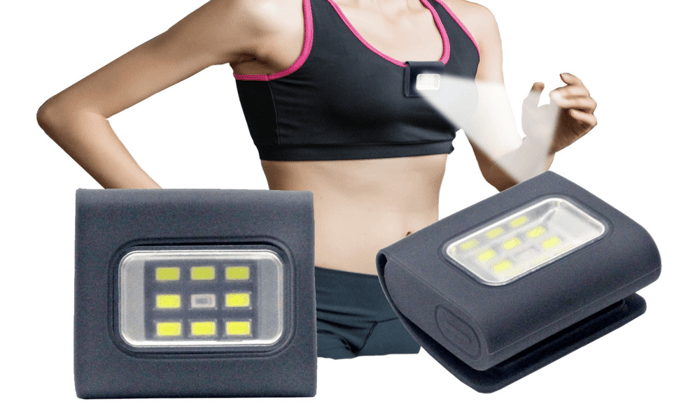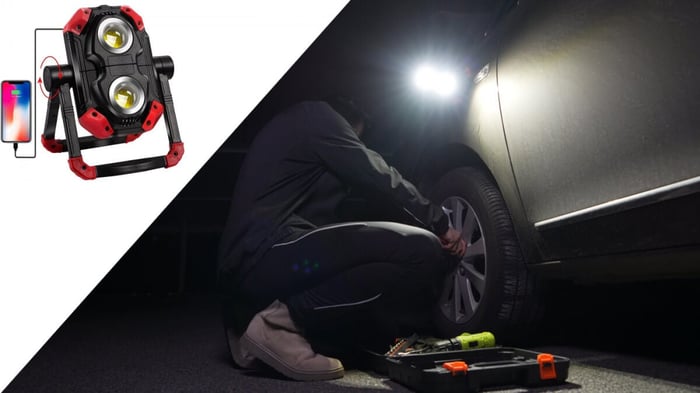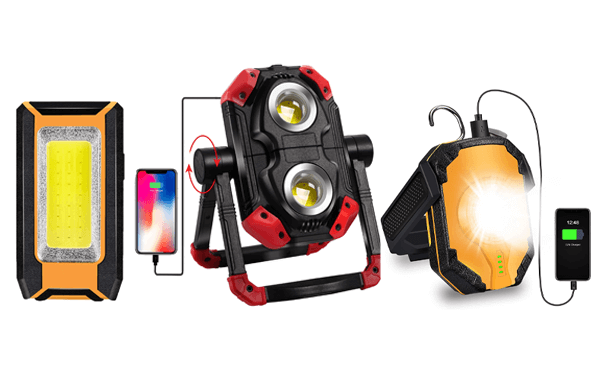Your Cart is Empty

Running Lights: The Ultimate Guide
Listen to article
Audio generated by DropInBlog's Blog Voice AI™ may have slight pronunciation nuances. Learn more
We have 12 hours of daylight, which you may believe is sufficient to enjoy during the day. Yes, it is sufficient to complete all tasks, while someone may have time for a quick run before dinner. But that is not the case with their hectic job, business, or anything else.
People are becoming more health-conscious, and they are aware of the negative effects of sitting for extended periods of time at work. As a result, running at night is the ideal solution for keeping them healthy and happy after a long day of work. It relieves the fatigue of a long day's work.
The issue, however, is a lack of light at night. Running lights appear at this point to illuminate the terrain ahead for slow and fast-paced long-distance runs. To improve usability, the best running lights and head torches are hands-free.
As there are so many options to choose from, this guide will help you find the top-quality running lights for your purpose. Likewise, Hokolite’s newly launched 300 Lumens Magnetic Silicone Running Light won the Red Dot Design Award.
Why Hokolite 300 lumens magnetic silicone running lights is the best?
Covered silicone
Heat-resistant silicone covers that are soft and flexible protect the running lights. The silicone covers act as a buffer, reducing the risk of damage from accidental falls. Silicone covers are ideal for improving the appearance of running lights due to their anti-slip properties.
Ultra-strong magnet adsorption
Hokolite night outdoor running lights are distinguished by the presence of two magnetic magnets that allow them to be attached to the dog's collar or pocket.
Because of the strong magnetic adsorption, running lights do not fall during the run, allowing runners to concentrate on enjoying the process more.
Best carrying sizes & Waterproof
This light only weighs 2 ounces and fits perfectly in the palm of your hand, allowing you to wear it anywhere on your body without restricting movement.
At the same time, it has passed the IEC529 IPX4 waterproof test. They are small and portable, making them ideal for any outdoor activity at night.
A variety of lighting modes
In the center of the Hokolite night running lights are nine separate 300 lumen LED beads. Illuminates the area in front of you as well as the area around you. High (300 lumens), Medium (150 lumens), and Strobe are the available light modes. Strobe mode can help other drivers and pedestrians notice you more quickly when running at night.
Rechargeable
If you are concerned about the environment, choose Hokolite night outdoor running lights with rechargeable batteries. When the running lights are low, it only takes 50 minutes to fully charge it.
Learn more about the new Hokolite 2021 300 lumens magnetic absorbing silicone running lights by watching the video below.
Video Link: https://www.youtube.com/watch?v=njM7RkDHKx4
Running Lights: The Ultimate Guide
What are the types of running lights?
Head torches or lamps:
Head torches or lamps are equipped with a head strap to keep them tight on the runner's forehead while running. They are hands-free and ideal for runners who want to concentrate on the trail ahead of them. The way it illuminates allows the runner to see everything in front of them clearly. The most significant advantage of having a running headlamp is that it can turn with your head.
Handheld lights:
It's the traditional way to illuminate the darkness while walking or running at night. It's a small torch or portable lamp that you can hold in your hands. It is preferable to point in any direction for a quick inspection. However, keep in mind that it is not a hands-free option and cannot cover a wide range.
Chest lights:
It’s pretty much similar to the headlamps, where it is equipped with a chest strap to enhance the illumination ability ahead. These lights can cover both the back and front of yourself and offer a nice hands-free lighting option for you.
Chest lights also feature different flashing modes and colors for your safety while running at night. These are the most convenient choice for you.
Shoe lights:
It’s not the best option for clear visibility ahead of yourself while running. But, they are hands-free and designed to be attached to the shoes. It only shows you the place where the feet are straying when running through a rough trail.
Shoe lights are recommended for a quite unknown trail where you need to focus more on the ground below.
Knuckle lights:
These are the smallest and lightweight options that come with straps place over the knuckles. They deliver a small amount of light, which may not be the best option for running at night through dark terrains.
What is the power source of running light?
Mostly, batteries are the power source of portable running lights. Either they can be rechargeable or not.
Battery-powered:
Most of the running lights or headlamps run on battery power. They get the power from the disposable batteries, from the AA size to small watch batteries. The more quality has your batteries offer the longer running time at night.
But, disposable batteries always demand to keep some extra sets in your pack while running a long distance in the dark. They also keep losing their power in freeze or cold weather conditions by about twenty percent of their performance.
So, choosing a battery-operated running light may not be the best option for you. Be aware while choosing disposable battery-powered running lights according to your needs.
Rechargeable running lights:
These lights are so much popular among the night runners, which offer not to replace the batteries anymore. Users can charge the batteries frequently to revive from the state of dying. These units power up through electric outlets or USB. It’s the ideal choice for night runners who can charge the lights at the office or in the car.
If you prefer eco-friendly running and do not like the frequent replacement of disposable batteries, choose a Hokolite Night Outdoor Running Light that comes with a rechargeable battery. You can recharge the outdoor running light in about 50 minutes through the USB port to attach to your laptop.
Wind up running lights:
It’s a light that can convert your muscle power into electrical power to illuminate the darkness. However, it’s not the ideal choice for the runner for regular use. You can have one in your pack as a backup!
What features do you need to consider for a running light?

Light modes
Running lights with multiple modes like strobe and flashing help to save energy. It also allows customizing your light levels so other sources of lights in urban areas may work for you in a manner. Having a running light with red light will increase your visibility to cars as well.
Our Hokolite night outdoor running light consists of nine separate LED beads, reaching 300 lumens. The LED lighting area reaches a 180 degrees wide-angle range with a beam illumination distance of 8-10 meters. All these options help users to view any obstacles surrounded by the area in front of runners.
It features three lighting modes to customize the light levels in different situations:
· High (300 lumens)
· Medium (150 lumens)
· Strobe
The strobe mode helps to grab other pedestrians or vehicles owners' attention while running at night. It ensures your safety in dark as well.
Waterproof
Double-check your running light is waterproof so it will remain safe if you run in a rainstorm. Otherwise, the most modern running lights are showerproof to stay safe on shorter runs.
The Hokolite night outdoor running lights have passed the IPX4 rating. It ensures its waterproof ability from heavy rain damages.
Better usability
The better usability determines the running light is easy to operate, comfortable to use, and safe. It also depends on how securely the light fits onto your forehead, or clothing.
It’s the loops or clips that come with the lights to ensure a secure fit. You can choose magnetic clips for strong adsorption. It will keep the light safe from falling while running at night.
Moreover, ask for an adjustable strap that will allow your running light to fit over a hat.
A few models are equipped with a heat-resistant silicone cover to protect them from heat. The cover also protects the light from an accidental fall offering an anti-skid surface.
Get all these features in the Hokolite night outdoor running light that comes with a silicone cover and two magnetic clips for the most comfort and safety.
Portability
Always look for a lightweight running light that prevents tension on your head and allows you to run bounce-free.
Price
It’s the lighting quality and safety to be considered primarily while choosing a running light for you. So,never look at the cheapest model that would be the right option to meet your needs safely.
What is the purpose of running lights?
Do I need a light to run at night?
The answer is yes because the light does not only help you see ahead but also makes you visible to others.
· It’s important equally to both seeing and being seen for your safety while running at night.
· Mixed-use trails are more dangerous than roads and sidewalks, if not more so.
· Wearing a light with multiple modes ensures the highest safety, which is the main purpose of night running lights.
· Running light illuminates the area in front of you to see the surrounding obstacles clearly visible while running in the dark. It helps you to avoid any tripping hazards as well.
· It will give you visibility of any traffic around you.
The principal purpose of wearing a running light is to make visible the area ahead of the runner. It ensures their safety while running at night.
What is the difference between COB VS LED?
COB LED is the latest technology that comes in a direct chip package on the board. It offers better light efficiency than SMD and reduces light loss. It requires five percent less manufacturing costs than SMD as well. Let’s point out a few specific things to differentiate these two LED technologies:
Produced light quality:
COB and SMD both technologies feature different numbers of diodes, which affects the illumination and production amount of light.
SMD produces light from the attachment of several light sources, which features a glare and is best for use as a point light.
COB produces glare-free light to provide an easily adjustable light beam. You can adjust a large angle beam to use it as the best surface light.
Efficiency:
Both LEDs are made with different features that also differ in their efficiency. COB LED offers higher production efficiency than LED.
Manufacturing Cost:
It’s not only the material cost manufacturing cost also consists of labor and manufacturing process to the material. It demands 15% of the material cost for SMD, which is 5% more than the COB LED.
Color and Color Temperature:
Color change and temperature flexibility are not possible for COB LED lights. COB lights are made to stick to one color light and temperature. On the other hand, SMD offers the most flexibility and provides a great array of color options to choose from. This technology also works if you want to change the temperature of the color.
Application
LED:
It offers flexibility to choose a different color from an array of options as well as the color temperature. These lights are perfect for signage and lighting retail shops, clubs, and other business places.
COB:
COB lights offer the best brightness and beam, which is great for use in industrial and security zones. These lights work better for seeing something from enough distance.
Brightness
The degree of brightness depends on the lumens produced by the integrated chips.
General LED works with 50 to 100 lumens/watt. This means that less energy is used with the higher lumen. When it comes to COB LED, a minimum of 80 lumens measurements are applied. It ensures brighter and better lighting compared to that of SMD.
-If you are judging for the best, it is a personal choice that depends on the application in the mind. However, COB stands out, especially when it comes to its features and amount of brightness.
How to Choose a Running light for Trail Running?
Consider the following features to get the best running light for trail running:
Best beam for running:
Choose a running light that features both a wide beam and a focused light.
The wide beam is wider, which increases the width of the light emitted but is precise the beam distance. Wide beams are great for illuminating trail edges, enhancing peripheral vision, or reading trail maps.
The focus of a focused, narrow beam is important for running at high speeds in the dark when a soft, wide beam is needed to run in a sunrise or a full moon. Most of the best running light (Hokolite night outdoor running light) offers both light modes so you can switch between them accordingly.
Lumens:
How many lumens do you need for trail running?
It depends on the terrain and speed of running you’ve planned to go with. But, it would be better to choose from a minimum of 200 to 300 lumens for overall trail running terrain and speed. If you would like to run in the darkest forest, you should have gone for more lumens than 300.
Moreover, it’s better to have a dimming adjustment ability for the runners, which will allow the users to increase or decrease the brightness onwards.
Light modes:
Different light modes help runners to switch on different situations. However, read light is a great feature for navigating crowded areas at night. It has not that disturbing brightness like white beam and uses less battery power enough for your night vision.
Battery power:
If you don’t like to replace batteries frequently, avoid choosing a disposable battery-powered running light or headlamp. Go for the lights that come with rechargeable batteries. Also, check that you can charge them quickly with a USB or power outlet both.
Weight:
Go for a lightweight running light that is essential to trail runners to avoid neck pain because of a heavier headlamp. The longevity of your running light along with the high brightness ability demands its heavier weight.
So, be aware while choosing a night light for trail running and try to balance the longevity and illumination according to your needs. It will help you cut down the weight for sure.
Fit for running fast:
Most of the running light comes with magnetic clips that ensure strong adsorption while running. Also, check out the strap is durable and adjustable so it will fit securely on your head or clothing.
Check out our 300 lumens magnetic silicone running lights
Durability & Waterproof:
Make sure your night light comes with a protective cover like a silicone cover to prevent damage from an accidental fall. Most of the running lights come with an IPX rating to state the water-resistant level. You must have to consider the level according to the weather and terrain.
Why do you need a night light for trail running?
A running light or headlamp can illuminate surrounding obstacles in the trail to keep the runners safe from hitting with a rock or root accidentally. It helps to avoid any tripping hazards and increases the visibility of yours to other trail users.
Running lights also feature different light modes that are better to switch on in different situations like running a bit on the road to reach your trail. It will make you visible to vehicles.
How many lumens do I need for night running?
If you would like to buy a night running light for road running, it doesn't require considering greater lumens. Consider about 40 to 50 lumens that are enough for running on the streets at night.
Unlike trail running, you highly need 100 lumens running light with the dim adjustable ability for night running. Thus, you can dim down to the minimum settings to maximize the battery life as well.
For all-around trail running, you should consider at least 200 to 300 lumens for better visibility of surrounding obstacles.
Are 200 lumens bright enough for running?
Night light with the ability of at least 200 lumens on its high mode is fair enough for nighttime running on road. I would recommend 100 to 150 lumens that are adequate for most needs except trail running, and route-finding at night. It should be 300 and up, which is better for trail running.





